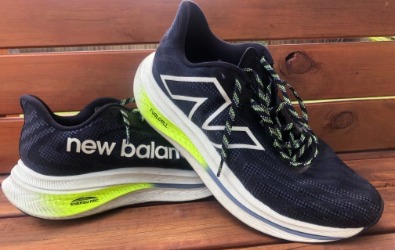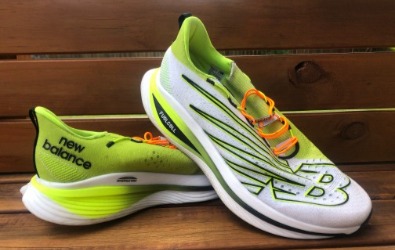Carbon Plated Running Shoes: A Cautionary Tale
Injuries, March 21, 2024
The article recounts Coach Rob's experience with a soleus muscle injury incurred while running. It highlights the potential consequences of overreliance on carbon-plated shoes, leading to muscle imbalance and strain. He emphasizes the importance of a balanced approach to footwear selection, proactive injury management, and seeking professional guidance to prevent future injuries and optimize performance.
This article has taken a while for me to write. I began it a few weeks after I first noticed a low grade tightening in my right soleus muscle, and here I am, four months later, able to finish the article now that the injury is fully healed.
In early November, I started feeling a tightening in my right soleus muscle during an easy run. It didn't bother me much unless I put in a few harder strides while running. Whilst I was well aware of it, I didn't let it change my training routine. Looking back, this was probably a mistake. Ignoring what seemed like a minor issue allowed it to linger and worsen.
During a comfortable-paced run about 20 minutes in, the dull ache in my soleus muscle tightened significantly, and was much worse than it had been previously. A normal stride became more difficult, and I had to walk the final kilometer of the run. At that moment, I realized it had become a more serious problem, and I suddenly regretted not addressing it sooner.
A soleus strain had been developing quietly in the background, initially unnoticed, then presenting as a warning sign. Due to my negligence, the muscle eventually reached its limit and progressed to a full blown strain.
Reflecting on the early stages of this muscle strain, I believe it was likely caused by relying too heavily on my carbon shoes during training, without balancing their use with conventional non-carbon shoes. This might sound ironic to those who know me well. I often advise caution when using carbon shoes for training, advocating for their use mainly during races or specific sessions. However, it seems I didn't heed my own advice. Every athlete is different, though, and what works for one person may not work for another.
There are a few interesting aspects of the gastrocnemius-soleus muscle complex (calf muscle), in particular the soleus muscle. While there are numerous detailed resources available on calf muscle injuries, there’s a very good one by Brad Beer of Pogo Physio. Here are a few interesting points I pulled from the article.
- More than half of the force generated during running propulsion comes from the muscles below the knee.
- The soleus muscle can generate peak forces of 6.5-8 times body weight, while the gastrocnemius muscle can produce forces of 3.5-4 times body weight.
- The soleus muscle generates similar high forces across various running speeds, from jogging to sprinting.
Despite being around for a few years, and used successfully on the professional and age group triathlon scene, there's still limited research on how carbon-plated running shoes directly affect calf function, especially the soleus muscle. While there's plenty of anecdotal evidence from athletes with calf and Achilles tendon injuries, the exact mechanism of injury remains unclear. Taking that into consideration, this is how I feel wearing carbon-plated shoes might alter muscle function. Throughout the running gait cycle, various muscle contractions and relaxations are necessary for smooth movement. One crucial contraction is the soleus muscle's role in propelling us forward from the forefoot. Carbon-plated shoes, along with their rocker-shaped midsoles, facilitate forefoot propulsion without requiring as much soleus muscle activation. This can lead to gradual weakening of the soleus muscle over time due to underutilization. When switching back to conventional shoes, the weakened muscle may struggle to handle the increased workload, resulting in strain and injury. As mentioned above, the Soleus muscle is exposed to very high peak forces, and much like a less muscular person taking on a weight session in the gym, they wouldn’t go straight to a very high load bench-press lifted over many repetitions.
Reflecting on my experience, I realized I had been wearing carbon-plated training shoes for most of my easy runs. While these shoes were comfortable and easy to run in, they didn't provide sufficient workout for my soleus muscles. Essentially, my muscles became lazy and weakened due to lack of regular activation. Then, during interval sessions with non-carbon shoes, my muscles were suddenly expected to work harder than they were conditioned for.
To address this, I've adjusted my shoe rotation. I now primarily use non-carbon shoes for aerobic runs (NB 1080 v13 or NB Fuel Cell Rebel v3), reserving carbon shoes (NB SuperComp Trainer v2 or NB SuperComp Elite v3) for specific sessions or races. This mix has proven effective for me, and I've regained confidence in my training routine.

New Balance Fresh FoamX 1080 v13

New Balance FuelCell Rebel v3

New Balance FuelCell SuperComp Trainer v2

New Balance FuelCell SuperComp Elite v3
Recovering from the injury took time and involved various treatments like dry needle acupuncture, massage, and taping thanks to Marthinus Brink of BE Physio. Gradually, with careful management and appropriate footwear, I was able to return to pain-free running after about eight weeks. I’m now having regular visits to Greg Pain of Biosport to help me with Core, Plyometrics and Power exercises to develop a stronger and more resistant chassis
Moving forward, I'm committed to maintaining a balanced approach to shoe selection, ensuring I match the shoe to the type of run I'm doing. It's essential to listen to your body and address any signs of strain or injury promptly, seeking professional guidance if needed. Ultimately, by being proactive and mindful of training choices, we can minimize the risk of future injuries and optimize performance.
